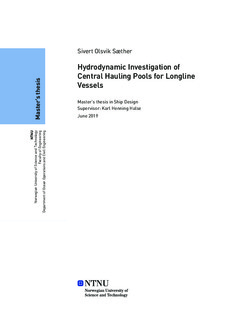| dc.contributor.advisor | Halse, Karl Henning | |
| dc.contributor.advisor | Piehl, Henry Peter | |
| dc.contributor.author | Sæther, Sivert Olsvik | |
| dc.date.accessioned | 2019-10-03T14:00:30Z | |
| dc.date.available | 2019-10-03T14:00:30Z | |
| dc.date.issued | 2019 | |
| dc.identifier.uri | http://hdl.handle.net/11250/2620150 | |
| dc.description.abstract | Dragerbrønnen har nå blitt en industristandard for linefartøy, men der har ikke vert mye forsking og utvikling på dragerbrønnen siden det første fartøyet ble sjøsatt i 1998. Skipsredere og designere har nå funnet rom for forbedringer. Denne hovedoppgaven vil ta for seg to forskjellige aspekter ved dragerbrønnen.
Det første aspektet ser på langskips plasseringen av dragerbrønnen og linerullen, for å finne posisjonen hvor linerullen opplever minst vertikal akselerasjon. Denne posisjonen er ønsket for å minske tapet av fisk under haling og begrense strekket på lina. Dette var undersøkt ved hjelp av programvarer som numerisk estimer fartøysrespons, ved hjelp av 2D stripeteori.
Resultatene viser at posisjonen til linerullen og dragerbrønnen er spesielt sensitive i møtende sjø, og den ideal plasseringen av linerullen og dragerbrønnen er aktenfor fartøyets oppdriftssenter. Der var på den andre siden noen begrensingene med resultatene, og disse er videre utdypet i dokumentet.
Det andre aspektet ved oppgaven så på utformingen av dragerbrønn røret. De første linebåtene bygget med dragerbrønn hadde et elliptisk rør, men dette ble endret til et sirkulært rør for å spare plass og at manøvreringen over linen visste seg å være enklere enn først antatt. Men noen ønskede effekter vart samtidig tapt i overgangen, som var egenskapet til å skifte ut vannet inne i dragerbrønnen i lave hastigheter. Intensjonen var å undersøke forskjellige utforminger og fastslå hvilken utforming som ville bidra til mer sirkulasjon av vannet for å unngå en oppsamling av skitten vann inne i dragerbrønnen.
Sirkuler, elliptisk og rektangulær utformede dragerbrønn rør var undersøkt, ved hjelp av numerisk fluiddynamikk simuleringer. En metode for å undersøke hvilken form som bidro til mest utskifting av vann ble utviklet, ved hjelp av passiv skalar transport. Den elliptiske og rektangulære dragerbønn røret visste potensiale, men der var på samme tid noen begrensinger ved den utvikla metoden. | |
| dc.description.abstract | The central hauling pool has now become an industry standard for the longline fishing vessels. On the other hand, there has not been done much research on the purpose-built moonpool for longline fishing since the first vessel was launched in 1998. Ship owners and ship designers have now found room for improvements, which this thesis addresses.
Two different aspects of the moonpool for the longline vessel were investigated in this thesis. The first aspect looked at the longitudinal placement of the moonpool and rail-roll, to find the location where the rail-roll has the lowest vertical acceleration to avoid tearing the fish of the hooks during hauling, and at the same time limiting the strain on the longline. This aspect was investigated with the use of a numerical vessel response estimation software, which utilized 2D strip theory.
The results show that the positioning of the rail-roll moonpool is especially sensitive for head seas wave conditions and that the ideal placement of the rail-roll is aft of the longitudinal center of buoyancy. There was however some limitations for the results obtained, and this is further elaborated within the body of this document.
The second aspect that was investigated in this thesis was the shape of the moonpool pipe. The first longline moonpools had an elliptical shape, but this shifted towards a circular shape to save space and that the maneuvering over the longline proved to be easier than first anticipated. Furthermore, some desired effects were at the same time lost in the transition, which was the ability to clean the water inside the moonpool at low speeds. The intention was to evaluate three different shapes to determine which form that was resulting in more circulation of the water to avoid an accumulation of the dirty water inside the moonpool.
Circular, elliptical and rectangular shaped moonpool pipes were subjects for investigation, and this was carried out using computational fluid dynamics simulations. A method with the use of passive scalar transport was developed to be able to differentiate between the different shapes by tracking the ability to clean the water in the moonpool. The results show that the elliptical and rectangular moonpool shapes provide a better behavior of cleaning out dirty water, but there was at the same time some shortcomings with the method developed. | |
| dc.language | eng | |
| dc.publisher | NTNU | |
| dc.title | Hydrodynamic Investigation of Central Hauling Pools for Longline Vessels | |
| dc.type | Master thesis | |
